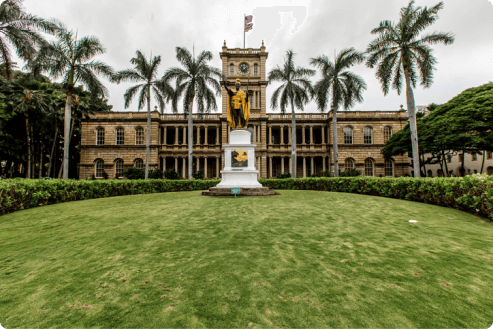
Honolulu, HI 96813
- $600 Million Recovered
- Serves Clients Nationwide
- 30+ Years Experience
Asbestos exposure in Hawaii has occurred in homes, public buildings and commercial and industrial job sites. Residents and workers who develop asbestos-related diseases may hire a mesothelioma attorney from a top law firm to help them recover compensation in Hawaii.

People in Hawaii who develop asbestos-related diseases, such as mesothelioma, may be eligible to file an asbestos claim in their state or another state. There are different types of claims, including personal injury lawsuits, wrongful death lawsuits and asbestos trust fund claims.
Hawaiian lawmakers have established specific rules, known as statutes of limitations, to manage asbestos claims in the state. Most statutes of limitations for mesothelioma claims are 1 to 4 years.
Key Facts About Filing in Hawaii
An experienced asbestos lawyer in Hawaii will help you file your mesothelioma claim. They can also decide if filing a claim in another state may benefit you. This may apply to you if you live in Hawaii but were exposed in another state or if the company responsible for your asbestos-related illness is headquartered in another state.
It’s in your best interest to work with a top asbestos lawyer in Hawaii who can get the compensation your family needs. They’ll work on your behalf to obtain the greatest compensation from negligent asbestos manufacturers that exposed you or your loved one to asbestos.
A knowledgeable mesothelioma attorney in your state can guide you through Hawaii’s specific rules and regulations. They’ll be able to navigate what you need to file an asbestos lawsuit in Hawaii. Top Hawaii attorneys will also ensure you’re filing within the statute of limitations and can assess if any exceptions apply to your asbestos case.
An experienced mesothelioma law firm in Hawaii will be familiar with asbestos-related lawsuits and the state court system. Hawaii law firms will also be locally licensed to handle your case quickly.

Hawaii-based mesothelioma firm Galiher DeRobertis & Waxman secured a $3.4 million settlement for an Oahu electrician who worked with toxic electrical products. The firm also helped a Honolulu man exposed to asbestos in the construction industry receive $1.5 million.
Mesothelioma law firms that practice nationwide have succeeded in securing compensation for many different types of cases. Based on the details of your case, they know the best state in which to file your claim. Plaintiffs may file outside the state where they live if their asbestos exposure happened in another state, for example. According to a 2019 KCIC industry report, about 54% of mesothelioma plaintiffs in the U.S. file their claims outside of the state where they live.





Another benefit of selecting a nationwide mesothelioma law firm is they’re willing to travel to you. Nationwide firms travel to mesothelioma clients. The firm pays the travel expenses, so the cost won’t end up on your bill.
Many multimillion-dollar verdicts and settlements resulting in mesothelioma compensation have been secured in Hawaii. Several of the cases reflect the state’s history of widespread asbestos use. The toxic mineral was used as a construction material for public buildings and commercial establishments across the Hawaiian Islands.
Notable Hawaii Settlements and Verdicts
The average mesothelioma settlement amount depends on the case. Settlements can range from $1 million to $2 million. The national average asbestos lawsuit trial verdict is $20.7 million.
Several factors can affect your verdict or settlement amount. Every mesothelioma case is different. Talk to your attorney about any factors that could affect your claim.
A combination of federal and state laws regulates asbestos throughout the Hawaiian Islands. The Hawaii State Department of Health oversees and enforces the state’s asbestos laws, including certifying abatement professionals and permitting asbestos removal projects.
Hawaii Asbestos Laws and Regulations
Both the Hawaiian and federal governments are undergoing cleanup projects to reduce future incidences of mesothelioma and other asbestos-related diseases across the state. The EPA has supervised the cleanup of 3 military facilities and 3 commercial establishments in Hawaii.

Get help finding an attorney who knows the process and can get you and your family the compensation you deserve.
Get Help NowNearly every building in Hawaii constructed before 1980, including homes, schools, state buildings and military bases, used asbestos products. Hawaii State Department of Health representative Thomas Lileikis confirms the widespread use of asbestos across Hawaii, saying residents are “living in and around it constantly.” The mineral is present in ceilings, floor tiles and drywall. Lileikis noted, however, that asbestos materials only pose a health hazard if damaged.
Sites in Hawaii Known for Asbestos Exposure
School officials in Hawaii have prioritized asbestos testing and abatement in recent years. Since 2001, asbestos has been found in more than 10 schools across the state, most on Oahu. Many asbestos-containing schools were damaged and required immediate abatement projects to ensure the safety of faculty, staff and students. Every school in Hawaii now has an asbestos management plan.
Workers in Hawaii have been exposed to asbestos at various job sites throughout the islands. High-risk Hawaiian occupations include construction and manufacturing. Veterans exposed in Hawaii may file a VA claim for benefits and have access to VA health care in Hawaii.
Higher-Risk Jobs in Hawaii
Hawaii is one of the states where residents can file a lawsuit against a company responsible for secondary asbestos exposure. Courts in Hawaii have held companies liable for asbestos-related illnesses when someone was exposed to asbestos a family member unknowingly brought home on their clothes, skin or gear from their workplace.
Recommended ReadingYour web browser is no longer supported by Microsoft. Update your browser for more security, speed and compatibility.
If you are looking for mesothelioma support, please contact our Patient Advocates at (855) 404-4592
The Mesothelioma Center at Asbestos.com has provided patients and their loved ones the most updated and reliable information on mesothelioma and asbestos exposure since 2006.
Our team of Patient Advocates includes a medical doctor, a registered nurse, health services administrators, veterans, VA-accredited Claims Agents, an oncology patient navigator and hospice care expert. Their combined expertise means we help any mesothelioma patient or loved one through every step of their cancer journey.
More than 30 contributors, including mesothelioma doctors, survivors, health care professionals and other experts, have peer-reviewed our website and written unique research-driven articles to ensure you get the highest-quality medical and health information.
My family has only the highest compliment for the assistance and support that we received from The Mesothelioma Center. This is a staff of compassionate and knowledgeable individuals who respect what your family is experiencing and who go the extra mile to make an unfortunate diagnosis less stressful. Information and assistance were provided by The Mesothelioma Center at no cost to our family.LashawnMesothelioma patient’s daughter


Lahav, J. (2025, April 25). Hawaii Mesothelioma Lawyer. Asbestos.com. Retrieved June 30, 2025, from https://www.asbestos.com/mesothelioma-lawyer/hawaii/
Lahav, Joe. "Hawaii Mesothelioma Lawyer." Asbestos.com, 25 Apr 2025, https://www.asbestos.com/mesothelioma-lawyer/hawaii/.
Lahav, Joe. "Hawaii Mesothelioma Lawyer." Asbestos.com. Last modified April 25, 2025. https://www.asbestos.com/mesothelioma-lawyer/hawaii/.
A mesothelioma lawyer who specializes in asbestos litigation reviewed the content on this page to ensure it is legally accurate.
William A. Davis is an attorney specializing in complex commercial litigation, with an emphasis in health care disputes, at a firm he founded in Washington, D.C. He also serves as senior counsel at The Peterson Firm.
Our fact-checking process begins with a thorough review of all sources to ensure they are high quality. Then we cross-check the facts with original medical or scientific reports published by those sources, or we validate the facts with reputable news organizations, medical and scientific experts and other health experts. Each page includes all sources for full transparency.
Please read our editorial guidelines to learn more about our content creation and review process.
